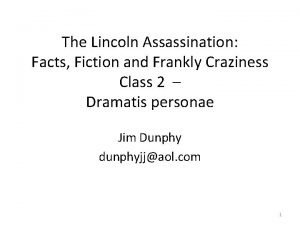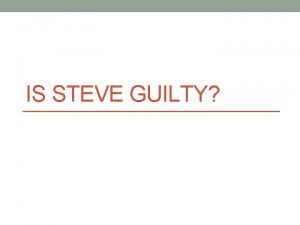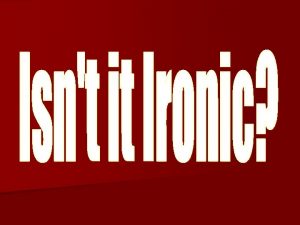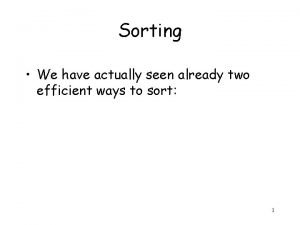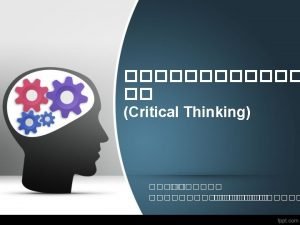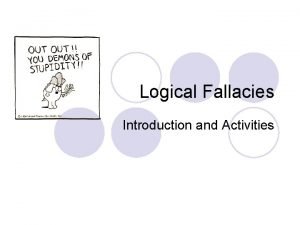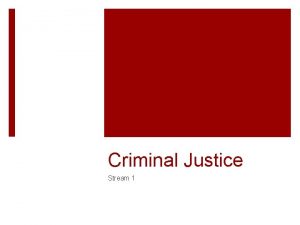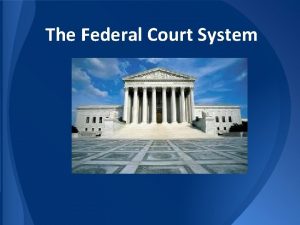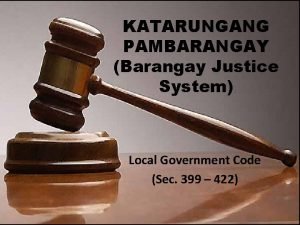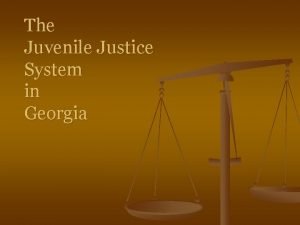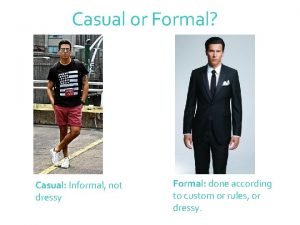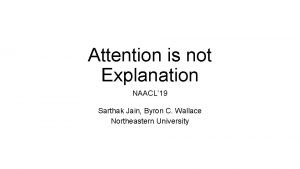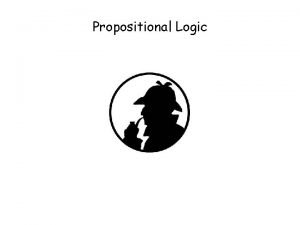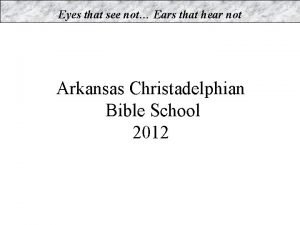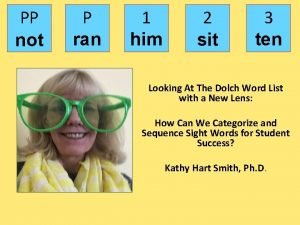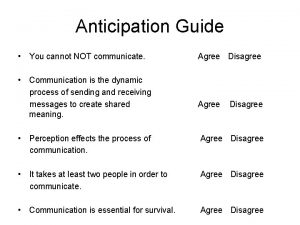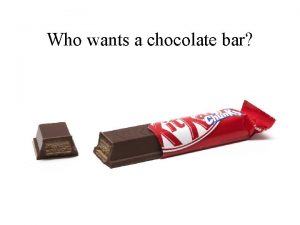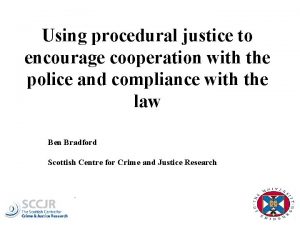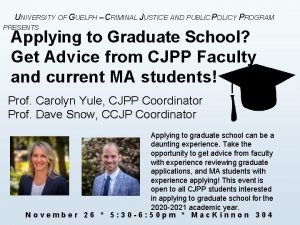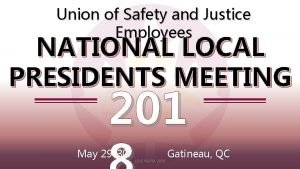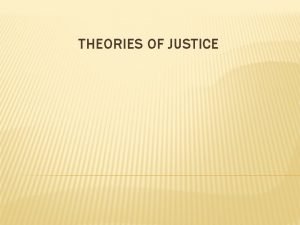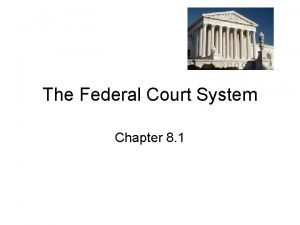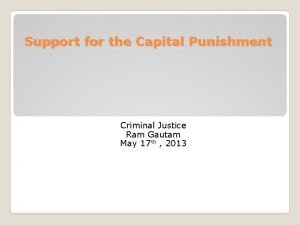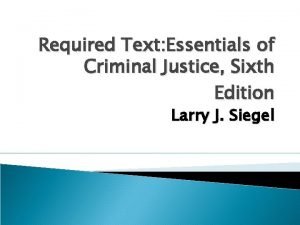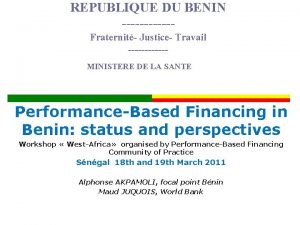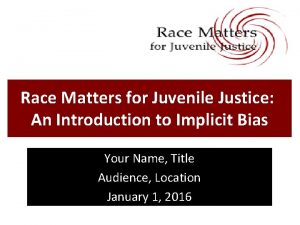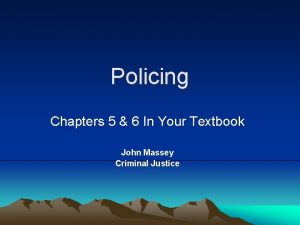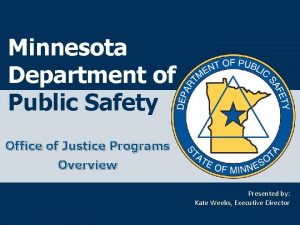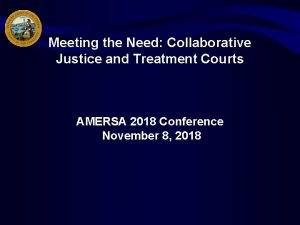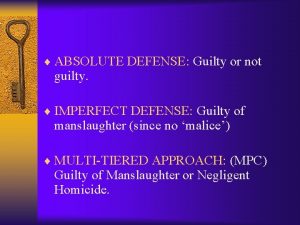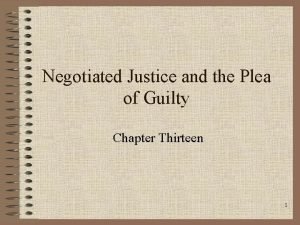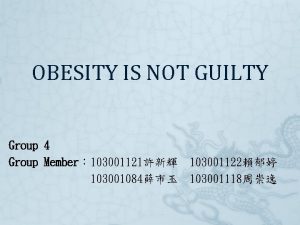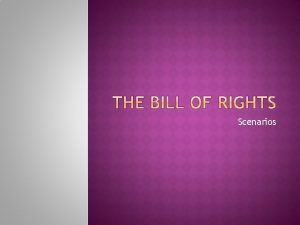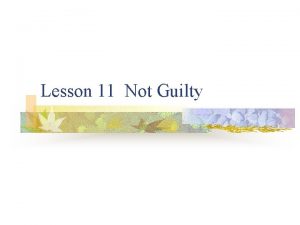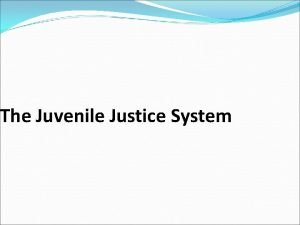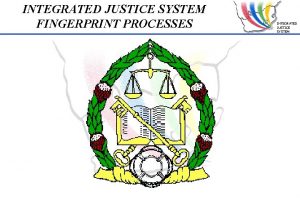U S Justice System Actually not guilty Actually








































































- Slides: 72

U. S. Justice System Actually not guilty Actually guilty Jury finds guilty e u Tr e v i it s o p e s l Fa Jury finds not guilty e s l Fa s o P e v i it e v i at g e N e v i at Tru g e en

False Positive – Wrong result in which the jury correctly indicates guilt when the defendant is not actually guilty (innocent). � False Negative – Wrong result in which the jury indicates the defendant is not guilty, when in fact they are guilty. � True Positive – Correct result in which the jury finds the defendant guilty and they are guilty. � True Negative – Correct result in which the jury finds the defendant not guilty and they are in fact not guilty (innocent). �

Drug Screening Subject does not use drugs Subject uses drugs Positive drug test e u Tr e v i it s o p e s l Fa Po e v i sit Negative drug test e s l Fa e v i at g e N e v i at Tru g e en

False Positive – Wrong result in which the test incorrectly indicates the presence of a condition when the subject does not actually have that condition � False Negative – Wrong result in which the test incorrectly indicates that the subject does not have a condition when the subject actually does have that condition. � True Positive – Correct result in which the test correctly indicates that a condition is present when it really is present. � True Negative – Correct result in which the test correctly indicates that a condition is not present when it really is not present. �

Subject does not use drugs Subject uses drugs Drug Screening Positive drug test Negative drug test True positive False Negative 44 6 False Positive True negative 90 860

Basic Concepts of Probability � Event – any collection of results or outcomes of a procedure � Simple event – an outcome or an event that cannot be further broken down into simpler components � Sample Space – for a procedure consists of all possible simple events.

Basic Concepts of Probability �

Deck of Cards � Procedure › I draw one card � Example of EVENT › The ace of spades › The queen of diamonds � Sample Space › List of all events {ace of spades, queen of diamonds, 2 of hearts, 3 of clubs…}

Deck of Cards � Procedure › I draw two cards � Example of EVENT › The ace of spades & queen of diamonds › 2 of hearts and 3 of clubs › 2 of hearts and queen of diamonds � Sample Space › List of all events {The ace of spades & queen of diamonds, 6 of hearts and 9 of spades…}

Rolling dice � Procedure › I roll two dice � Example of EVENT › 3+4 › 1+6 › 4+3 � Sample Space › List of all events {3+4, 1+6, 4+3…}

Smoke alarm � Procedure › I test the smoke alarm � Example of EVENT › Alarm (positive) › No alarm (negative) � Sample Space › List of all events {positive, negative}

Smoke alarm � Procedure › I test the smoke 20 times � Example of EVENT › pppppnppppp › pnppppppppnp � Sample Space › List of all events {pppnppppnnppppp, pppppppppp}

Three approaches to probability �

� Experimental v. Theoretical Probability

Procedure – flipping coins � Probability when we flip a coin three times that we get TAILS, TAILS › Experimental Design �Flip a coin 3 times �Count the number of trials, Count the number of Trials with TTT › Theoretical Design �Count the number of outcomes in the sample space �Count the number of outcomes in the event


Subjective Probability � Probability you'll die in a plane crash � Probability you'll have to use the Heimlich Maneuver � Getting struck by lightning � Being Mauled by a polar bear and a regular bear on the same day

Homework � P 145 #8, 21 -28, 31, 37 -40

Probability 4 -3 The Addition Rule

Compound Event �

Subject does not use drugs Subject uses drugs � Positive drug test Negative drug test True positive False Negative 44 6 False Positive True negative 90 860

Dice �

Playing Cards �

Disjoint Events (Mutually Exclusive) � Events A and B are Disjoint (or mutually exclusive) if they cannot occur at the same time. › Disjoint examples �Selecting someone who is a registered democrat, selecting someone who is a registered republican › Not Disjoint �Selecting someone who is taking statistics, selecting someone who is female.

Not Disjoint �

Complimentary Events �




P 156 # 40, 42, 43 �

Homework � P 153 #2, 3, 5 -12, 27 -30

Probability 4 -4 The Multiplication Rule

� OR – addition � AND – Multiplication › The probability that event A and event B both occur. � Careful to make sure that the occurrence of Event A does not affect the probability of Event B


� Independent events – The occurrence of event A does not affect the probability of the occurrence of event B. � Dependent events – not independent. � Rolling 2 dice? � Drawing 2 cards?

Cards �

Sports 12 Band/Choir 5 3

Rationale for multiplication rule �

Sample Space � T, a � T, b � T, c � T, d � F, a � F, b � F, c � F, d

5% Guideline for Cumbersome Calculations � When Sample Size is no more than 5% of the size of the population, treat the selections as being independant

Drug Screening �

Light Bulbs �

Light Bulbs �

Homework � P 164 #5 -16, 18, 20, 21

Probability 4 -5: Multiplication: Complements and Conditional Probability

The Probability of “At Least One” � The probability of ”at least one” is the same as saying ” 1 or more” � At least one LITERALLY means the complement of “none”

At Least One �

Conditional Probability �

Sports 12 Intuitive Approach Band/Choir 5 3 Formula Approach

Sports 12 Intuitive Approach Band/Choir 5 3 Formula Approach


Homework �P 172 #5 -10, 15, 16, 19, 20, 23 -26

Probability 4 -6 Counting: Permutations & Combinations

Counting � Review: 4 -2 – 4 -5, avoid formulas � 4 -6: large sums � Permutations � Combinations

Permutations v Combinations � Permutation - arrangements in which different sequences of the same items are counted separately. � Combinations – arrangements in which different sequences of the same items are not counted separately.

Permutations v Combinations � Permutation Position � Combination Committee

Fundamental Counting Rule �

Fundamental Counting Rule � If a license plate follows the rule of 3 letters followed by 4 numbers, how many different license plates can be printed? � If a license plate can have 7 character (numbers or letters) printed in any order, how many different license plates can be printed?


� 11 math teachers sign up for Run with Carl. In how many different ways can the math teachers finish 1 st, 2 nd, & 3 rd? � What is the probability of this finishing order? › Belby 1 st › Pitcher 2 nd › Spelhaug 3 rd

� 3 of the math teachers are selected to be on a special committee. How many different 3 person committees can we make? � What is the probability of selecting Belby, Pitcher & Spelhaug?

� One hundred people purchase raffle tickets. Three winning tickets will be selected at random. If first prize is $100, second prize is $50, and third prize is $10, in how many different ways can the prizes be awarded?

Combination v. permutation � Permutations are an ordered list › Order is important › Selected objects should be treated differently › Key words – order or arrangement � Combinations are unordered lists › The order of selection is irrelevant › Selected objects are treated the same › Key word – group

Total number of elements in the set “n Permutate r” or “n arrange r” Number of elements not selected

Total number of elements in the set “n choose r” Number of elements selected Number of elements not selected

Permutation (identical items) �

Permutation (identical items) �

Powerball � Pick 5 numbers 1 to 69 � Powerball 1 to 26 � Pick 5 numbers 1 to 59 � Powerball 1 to 39


Homework � P 180 #5 -10, 13 -16, 21, 34

Seating chart How many ways can I arrange this pod with a class of 28 students? � How many different 4 person pods can I make from the students that class? �

Seating chart In a class with 17 girls and 11 boys, what is the probability that this pod will be all girls? � What is the probability that this pod will have 3 girls and 1 boy? � What is the probability that this pod will have 2 girls and 2 boys? �
 The guilty vicarage
The guilty vicarage Dr leale
Dr leale Remembrance emily bronte
Remembrance emily bronte Themes in macbeth
Themes in macbeth Rebuttal transition words
Rebuttal transition words Is steve guilty
Is steve guilty Guilty before god
Guilty before god In christ alone who took on flesh
In christ alone who took on flesh Sadlier unit 1 level d synonyms
Sadlier unit 1 level d synonyms Summary great gatsby chapter 8
Summary great gatsby chapter 8 Most inhalants are actually intended to be _______________
Most inhalants are actually intended to be _______________ What are the two basic requirements for a healthy scalp?
What are the two basic requirements for a healthy scalp? What are the example of ideal self
What are the example of ideal self Contrast between what is expected and what actually happens
Contrast between what is expected and what actually happens The elements which you have actually seen
The elements which you have actually seen Critical thinking definition
Critical thinking definition Wind energy is indirect form of
Wind energy is indirect form of Actually that was america
Actually that was america Potential synoynm
Potential synoynm What is logic
What is logic Four pillars of criminal justice system
Four pillars of criminal justice system Supreme court justice system
Supreme court justice system Arizona criminal justice information system
Arizona criminal justice information system Responsibilities and functions of saps
Responsibilities and functions of saps Polisiyang pambarangay
Polisiyang pambarangay Juvenile justice system georgia
Juvenile justice system georgia The american system of criminal justice 16th edition
The american system of criminal justice 16th edition Ra 9344 cases
Ra 9344 cases Integrated justice system
Integrated justice system The american system of criminal justice 16th edition
The american system of criminal justice 16th edition Notas rojas
Notas rojas Juvenile justice system in georgia
Juvenile justice system in georgia Minnesota juvenile justice system
Minnesota juvenile justice system If you're not confused you're not paying attention
If you're not confused you're not paying attention Informal and casual
Informal and casual Attention is not not explanation
Attention is not not explanation Not too narrow not too deep
Not too narrow not too deep If p then q
If p then q Not too big not too small just right
Not too big not too small just right Edna st vincent millay love is not all
Edna st vincent millay love is not all Ears that hear and eyes that see
Ears that hear and eyes that see P ran
P ran If you can't measure it, you can't manage it
If you can't measure it, you can't manage it We will not be shaken we will not be moved
We will not be shaken we will not be moved Not a rustling leaf, not a bird in flight
Not a rustling leaf, not a bird in flight You cannot not communicate
You cannot not communicate Is the earth a closed system
Is the earth a closed system Respiratory system circulatory system digestive system
Respiratory system circulatory system digestive system Distributive justice definition
Distributive justice definition Procedure justice
Procedure justice Guelph university criminal justice and public policy
Guelph university criminal justice and public policy Usje union
Usje union Theories of justice
Theories of justice Tempest themes
Tempest themes Lady justice symbolism
Lady justice symbolism Court
Court Justice for jenny
Justice for jenny Retributive justice examples
Retributive justice examples Connecticut division of criminal justice
Connecticut division of criminal justice Social justice definiton
Social justice definiton Jvn video
Jvn video Retributive justice examples
Retributive justice examples Justice diamante
Justice diamante Rehabilitative justice examples
Rehabilitative justice examples What is the criminal justice funnel
What is the criminal justice funnel Fraternite justice travail
Fraternite justice travail Race matters for juvenile justice
Race matters for juvenile justice Principles of restorative justice
Principles of restorative justice Grass eater police
Grass eater police Three stars in the pnp seal symbolize
Three stars in the pnp seal symbolize Office of justice programs mn
Office of justice programs mn Discuss the nature and concept of collaborative justice.
Discuss the nature and concept of collaborative justice. Law and justice commission of pakistan
Law and justice commission of pakistan

